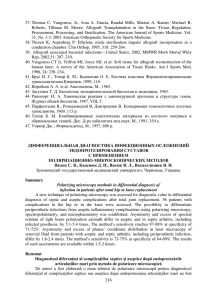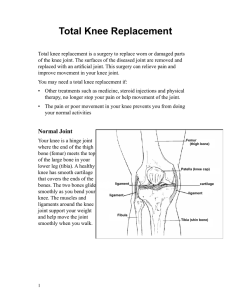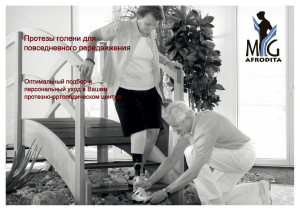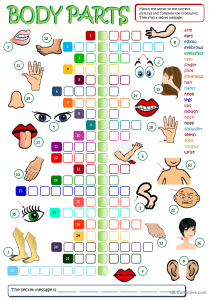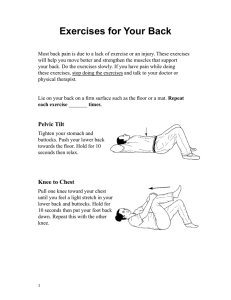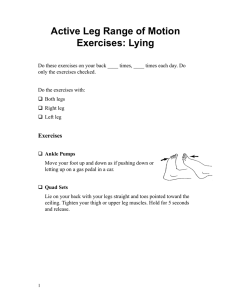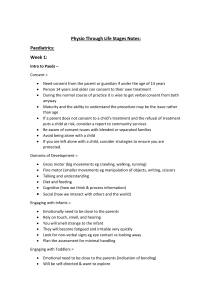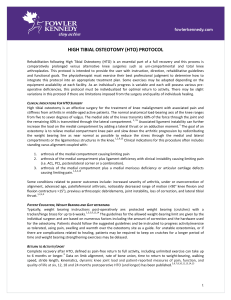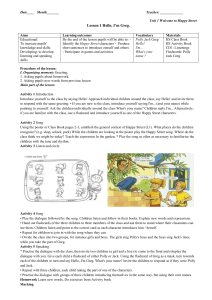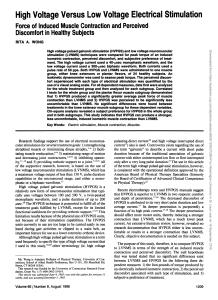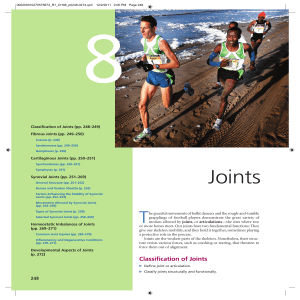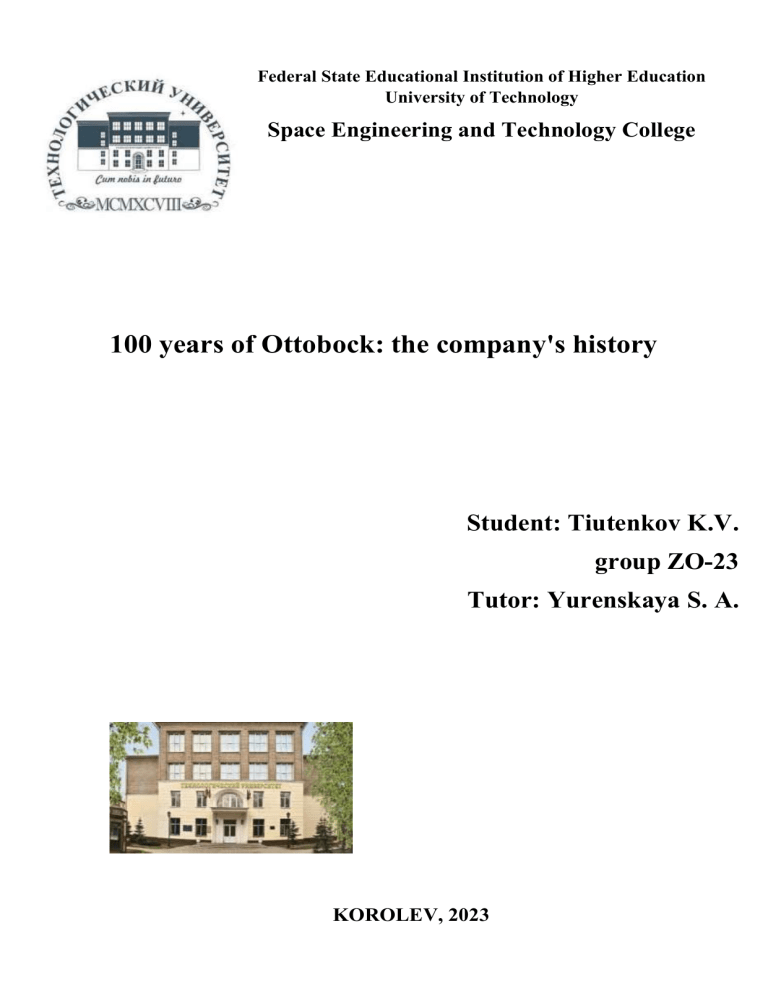
Federal State Educational Institution of Higher Education University of Technology Space Engineering and Technology College 100 years of Ottobock: the company's history Student: Tiutenkov K.V. group ZO-23 Tutor: Yurenskaya S. A. KOROLEV, 2023 brace [breɪs] - ортез knee [ni:] – колено myoelectric ['maɪəuɪ'lektrɪk] - миоэлектрический; использующий биотоки мышц orthopaedic [ˌɔːθəu'piːdɪk] – ортопедический obstacle ['ɔbstək(ə)l] – препятствие socket ['sɔkɪt] – суставная ямка victim ['vɪktɪm] – пострадавший wheelchair ['wi:lʧeə] - инвалидная коляска workforce ['wɜːkfɔːs] – сотрудники 100 years of mobility for people It all began in 1919 with the founding of a startup by Otto Bock – but through the intervening years, it has fundamentally changed the field of orthopaedic technology. Fourth generation of family businesses From startup to global market leader. In 1919, Otto Bock founded Orthopädische Industrie GmbH – a bonafide startup in today’s terms – in the Kreuzberg neighbourhood of Berlin. By introducing the fabrication of components for prostheses, the company succeeded in quickly and reliably treating the numerous victims who had returned from World War I. Due to political unrest in Berlin, Otto Bock relocated the young company to his hometown, Königsee in Thuringia, the same year it was founded. Over the next 30 years or so, the company workforce grew to more than 600 employees. German separation: both an end and a beginning. During the period of Soviet occupation, the family decided to establish another location as close as possible to Königsee but in the neighbouring British zone for strategic reasons. The aim was to ensure ongoing deliveries to customers from this location by trading materials for finished products. Dr Max Näder was the founder of what was the “branch” at the time and is now the company headquarters. Son-in-law to Otto Bock, Dr Näder and his wife Maria Näder started in 1947 with practically nothing and built up the location in Duderstadt. The Königsee location is expropriated After what was probably the most severe misfortune in the company’s history, the expropriation of the Königsee site without compensation, the family also had to rebuild production in Duderstadt from the ground up together with a group of dedicated employees. During the Cold War, the family took first steps towards internationalising the company. They secured the company’s future by establishing multiple locations around the globe. In 1958 Dr Max Näder founded the first Ottobock foreign subsidiary in Minneapolis in the US. Technological milestones Ground-breaking technology Technological milestones Jüpa knee Following a somewhat difficult start, the Jüpa knee – which featured a brake mechanism and offered a high level of stance stability – brought a business breakthrough in 1949. This product, together with an innovative balance device and two additional prosthetic alignment apparatuses, were in high demand on the American market. Max Näder exported the first 500 units of the Jüpa knee to the US in 1955. Myoelectrics Max Näder introduced myoelectric arm prostheses to the market in 1965. For the first time, people could grasp light and fragile objects as well as heavy items. Myoelectrics make it possible for weak electric voltages to control the prosthesis. Every contraction of the residual limb produces muscle action currents, which are used as control signals for the artificial hand with the help of electrodes. Modular system Dr Max Näder coined the phrase “humanising prostheses” by further expanding the Ottobock component system to include a modular leg prosthesis. The pyramid patented in 1969 joins the prosthetic foot, knee joint and socket, making it possible to carry out static corrections and exchange the modules. It remains an integrative element for innovative joints to this day. Paralympic Games The beginning of a decades-long partnership Four O&P professionals from Australia started the ball rolling when they provided technical assistance to athletes at the Summer Paralympic Games in Seoul 1988. This laid the foundation for a commitment that has now lasted more than three decades, and today is known under the motto “Passion for Paralympics”. Ottobock has been attending and supporting the Summer and Winter Paralympic Games with their technical service ever since. Growth through globalisation and internationalisation A turning point in the company's history The fall of the Berlin Wall was another turning point in Ottobock’s history. This enabled the company to repurchase its production location in Königsee, where cutting-edge wheelchairs are now produced. The group’s international growth also continued around the globe. A forward-looking company In 1990, Dr Max Näder handed over management to his son Professor Hans Georg Näder. Trendsetting innovations Microprocessors in orthopaedic technology Technological milestones C-Leg Hans Georg Näder recognised the potential of a groundbreaking innovation – a computerised (C) leg designed by Canadian Kelly James – and acquired the patent. After five years of development work, he was able to present the C-Leg, the world’s first microprocessor-controlled knee joint, at the Prosthetics World Congress in Nuremberg. The C-Leg opened up a new dimension in walking in 1997. Genium Thanks to the evolution of the C-Leg 4, Kenevo and Genium X3 electronic knee joint components and mechatronic prosthetic feet, highly customised treatment is now an option – regardless of the user’s age and level of mobility. In 2011, new developments meant that people were able to walk backwards safely with their prosthesis for the first time – as well as stepping over obstacles and negotiating stairs step-over-step. C-Brace and Paexo The new generation of the C-Brace® orthotronic mobility system revolutionised treatment for people with symptoms of paralysis in 2018. It uses innovative sensor technology to control the stance and swing phase of the leg during the entire gait cycle. As a result, the user can walk with a nearly natural gait pattern. The Paexo exoskeleton, the first product from the new Ottobock Industrials business area, reduces strain during overhead work.
